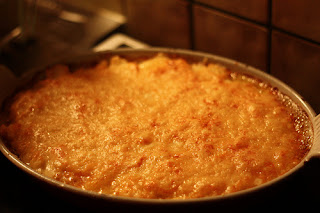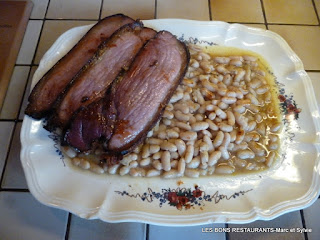from
Behind the French Menu
by
Bryan G. Newman
behindthefrenchmenu@gmail.com
Aging Gruyere cheese.
https://www.flickr.com/photos/sopramais/1815952997/
Both Swiss Gruyere AOP and French Gruyere IGP are fabulous cheeses. They are hard, ivory-to-yellow cow’s milk cheeses made with unpasteurized milk. The cheeses are made with the milk from cows that graze freely in the summer. In the winter, the cows are fed on fodder collected in the summer, with no silage permitted. The calves are raised with their mothers, and no antibiotics or growth hormones may be used. The color of the cheese’s pate varies with the time of year and the grasses upon which the cows feed. No extraneous substances may be added to the cheeses, and that includes natural food coloring. Each country’s cheese is produced in defined geographical areas.
Gruyere Français - French Gruyere
French Gruyere has approximately 32% fat and is aged for a minimum of four months. The cheese is slightly nutty with a very slight salty accent and is considered to be slightly sweeter than Swiss Gruyere. Taste a slice of French Gruyere with Swiss Gruyere with French bread, as I have done, and the difference is immediately apparent. Their tastes become more full-bodied as the cheeses age. The color of the rind varies from a pale orange to brown, darkening the longer the cheese is aged. Swiss Gruyere has no holes (the famous Swiss cheese with all the holes is Emmental), while French Gruyere has a number of small holes. French Gruyere’s holes are officially part of the cheese, and they may vary in size from a pea to a cherry. French Gruyere IGP is produced in the departments of Doubs, Haute-Saône, Savoie, and Haute-Savoie that border Switzerland
French Gruyere cheese.
Gruyere cheese in the French cuisine:
Gruyere cheese is probably the most important French cheese in the French kitchen, though by name, it may only be on menus when part of a salad or cheese plate. Dishes with Gratin or Gratinée in their name will have been browned under the grill, often with the aid of French Gruyere cheese.
Croque Monsieur - Croque Monsieur is a simple but tasty French fast food; it is a toasted sandwich made with Pain de Mie, French sandwich bread, cooked ham, and Gruyere cheese. The sandwich is soaked in beaten egg and then fried gently or toasted until the outside is golden brown and the cheese inside melts.
Croque Monsieur
www.flickr.com/photos/mager/3098810358/
Croque Madam – The same as a Croque Monsieur, but with a fried egg on top.
Escalope de Veau Cordon Bleu - A veal cutlet wrapped in ham and gruyere cheese, covered in breadcrumbs and fried. (Escalope Cordon Bleu is a dish from the mid-20th century; however, the Cordon Bleu, the award of the blue ribbon, is much older. The Cordon Bleu was part of an award created by King Henry III of France in 1578 for outstanding service to the French Crown).
N.B. A menu listing may offer Escalope Cordon Bleu de Dinde which is made with turkey breast, and Escalope Cordon Bleu de Poulet is made with chicken breast. Read the menu carefully.
Escalope de Veau Cordon Bleu
Fondue Savoyarde – The cheese fondue from the departments of Savoie. Cheese fondues were on home menus in the region of Savoie long before skiing became fashionable. Then one or two local cheeses, along with a small amount of garlic, were melted together with a local white wine for an enjoyable family meal. The fondue is eaten with pieces of bread that are dipped in the melted cheese on a special fork. Each diner will have been given his or her fourchette à fondue, a distinctive, long fondue fork that keeps the diner’s hand away from the communal pot of melted cheese in which the bread will be dipped. N.B. These fondue forks become extremely hot at the tip, and they have burned many a tongue. I speak with experience, so transfer the bread to your plate and then to an ordinary fork before eating.
Fondue Savoyard.
www.flickr.com/photos/pcerqueira/5402321948/
Recipes for dishes similar to today’s cheese fondues date back two or three hundred years. Every fondue will include two or three cheeses from the Gruyere family chosen from among Abondance, Beaufort, Comté, French Emmental, and French Gruyere. Many cheese fondues will be made with the Savoie’s much-appreciated kirsch cherry brandy, while others will have added Madeira wine.
Galette Bretonne – A traditional pancake from Brittany made with buckwheat flour, its blé noir, black flour, also called the farine de sarrasin, the flour of the Saracens. A Galette Bretonne may be served with a variety of garnishes, though the most traditional would be salted butter, fried eggs, ham, and grated French Gruyere cheese.
Galette Bretonne
www.flickr.com/photos/jack_tt_lee/16101541931/
Gratin Dauphinois – Baked sliced potatoes cooked in milk and cream, flavored with nutmeg, garlic, thyme, and shallots, and then browned under the grill, usually with Gruyere cheese.
Gratin Dauphinois
Photograph courtesy of Pierre Guinoiseau
www.flickr.com/photos/geekounet/3937031101/
Soupe à l’Oignon – Onion Soup. There are traditional differences between the two most famous onion soups. The Paris recipe calls for the use of vegetable, chicken or beef stock, or bouillon, and wine or Cognac. The original Lyonnais version uses no stock, and the alcohol is Madeira wine or Port wine. Both soups will be served with grated French Gruyere cheese browned under the grill.
Soupe à l’Oignon, Soupe à l’Oignon à la Parisienne, Gratinée Parisienne or Gratinée des Halles - Among the many names used for onion soup in the tradition of Paris.
Gratinée Lyonnais, Soupe à l'Oignon Lyonnaise or Soupe à l'Oignon Gratinée - Among the many names used for onion soup in the tradition of the city of Lyon.
Gratinée Parisienne – Parisian Onion Soup.
www.flickr.com/photos/jseita/7137856773/
The Gruyère cheese family.
French Gruyere IGP is produced in the departments of Doubs, Haute-Saône, Savoie and Haute-Savoie that border Switzerland. Here and in adjoining departments, many kinds of cheese have been developed over the centuries, with Abondance, Beaufort, Comté, and French Emmental all considered Gruyere-type cheeses. Two hundred years ago, Brillat-Savarin, the first philosopher of food, called Beaufort cheese the Prince of the Gruyères. To confuse us all even further one of the official names for Comté cheese is Gruyère de Comté. When you are looking for Gruyere in France, look at the label.
Buying French gruyere cheese and flying home it.
Few restaurants, if any, will offer different ages of Gruyere to choose from. Restaurant clientele, understandably, expects the restaurant to use aged cheeses. To test the difference between young and aged Gruyere and find the one that suits your taste visit a good fromagerie, a cheese shop. Quite a number of the better fromageries will stock two different French Gruyeres. The youngest may be a minimum of four months, and the older cheese may be up to a year old, occasionally even older. If you look like a serious customer, you may be offered a sliver of each to try.
The USA, which prohibits the import of unpasteurized milk cheese aged for less than 60 days, permits the import of Gruyere Française IGP. It has been aged for four months. However, before leaving France and arriving at the check-in counter, check your baggage weight allowance. The average weight of a wheel of Gruyere is 42 kilos (92 lbs), and that is a good reason to take a smaller wedge of this excellent cheese home. As Gruyere is an aged hard cheese, a wedge wrapped in plastic will travel well for three or four days. Once home, keep it in the refrigerator, still wrapped in plastic, not the freezer. To prepare the cheese for serving, take it from the refrigerator, cut off the amount you will be using, and let it rest for an hour before serving. Return the rest of the cheese to the refrigerator for later use. Kept wrapped in plastic in a refrigerator Gruyere will keep well for five to six weeks. (For more about buying cheese in France and taking it home, click here).
N.B., The UK permits the import of unpasteurized cheeses from the European Union.
The French Gruyere association only has a French language website; however, it is easily understood with the Google and Bing translation apps.
Swiss Gruyere was first.
The origins of Gruyere cheese are undeniably Swiss. Though neither Switzerland nor France existed as the nation-states with today's borders when Gruyere was first made. The cheese is named after the town of Gruyères (with an s), in the Swiss Canton of Fribourg. The Swiss Gruyere cheese has a history that can be traced back 900 years, while the French cheese has only been made for 800 years. With such a long history the French and Swiss have ended up agreeing to share the name. As the primary owner of the name, the Swiss received the prestigious Pan-European AOP. French Gruyere has an IGP (English PGI - Protected Geographical Indication). The packaging must clearly note “Made in France.”. The town of Gruyeres is approximately 160 km (100 miles) from the nearest French border.
A French Gruyere label.
It all goes back to Emperor Charlemagne
Going further back in time, the Swiss town of Gruyeres took its name from Emperor Charlemagne’s tax collectors. These tax collectors were called Gruyers and received taxes in the form of cheese. Paying your tax with wheels of cheese usually will not work today, but you can try! Emperor Charlemagne (742 – 814) was the Holy Roman Emperor and ruled most of Europe and is considered the founder of France and Germany. Charlemagne is buried in the town of Aachen in Germany; the town is called Aix-la-Chapelle in French. (That is the Aix in Robert Browning’s galloping poem: "How They Brought the Good News from Ghent to Aix" is Aix-la-Chapelle).
Connected Posts:
Behind the French Menu’s links include hundreds of words, names, and phrases that are seen on French menus. There are nearly 400 articles that include over 2,000 French dishes with English translations and explanations. Just add the word, words or phrase that you are searching for to the words "Behind the French Menu" and search with Google.


















